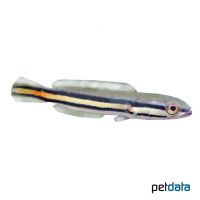Giant Snakehead (Channa micropeltes)
| Giant Snakehead Channa micropeltes | |
|---|---|
| Name | Giant Snakehead |
| Name Lat. | Channa micropeltes |
| Family | Snakeheads |
| Family lat. | Channidae |
| Order | Labyrinth Fishes |
| Order lat. | Anabantiformes |
| Origin | Southeast Asia |
| Habitat | Rivers, lakes, swamps |
| Diet | Carnivore |
| pH | 6.0-8.0 |
| Behavior | Predatory |
| Keeping | Individual |
| Care Level | Experts only |
| Reproduction | Nest builder |
| Breeding | Difficult |
| Life Span | 5-10 years |
| Protection | No |
| Metric Units | |
| Size | 100-130 cm |
| Temperature | 20-30 °C |
| Hardness | 2-20 °dH |
| Aquarium | ~ 1,000 l |
| US Units | |
| Size | 39"-51" |
| Temperature | 68-86 °F |
| Hardness | 36-356 ppm |
| Aquarium | ~ 260 gal |
Distribution and habitat
Large snakeheads are widely distributed in Southeast Asia, from the Mekong River in Laos, Thailand and Cambodia, through Malaysia to Sumatra, Java and Borneo. They live in slow-moving or stagnant waters, such as rivers, lakes and swamps, usually under overhanging riparian vegetation and floating plants among branches, roots and stones.
Maintenance
The spacious aquarium should have robust perimeter planting, plenty of hiding places from large rocks and roots, and adequate swimming space. A dark sand substrate and subdued light (floating plants) is ideal.
No ammonia, ammonium and nitrite should be detectable, the nitrate value should not exceed 100 mg/l. To ensure water quality and oxygen content, a filter and heater adapted to the aquarium size is required, as well as lighting for the species-appropriate day-night rhythm of the animals.
Diet
They are greedy and voracious predators that feed mainly on fish and crustaceans in nature. The diet consists of insect larvae, shrimp, mysis, small crustaceans, crab meat and fish, which is also readily accepted frozen, or a commercially available frozen food mix, according to their size. Dry food is occasionally accepted, but should not be the main diet.
Only as much should be fed as is eaten immediately (in a maximum of 10 minutes). Regular and varied feeding promotes health and avoids deficiency symptoms
Behaviour and compatibility
Juveniles are compatible with each other, but adults behave extremely aggressive within the species. Accordingly, only single keeping is recommended. They can only be socialized with other large and defensible fish, because they eat everything that fits into their mouth.
Basically, only mutually compatible fish species with similar demands on water quality and water temperature may be socialized.
Sex dimorphism
The females are thicker than the males at spawning time.
Reproduction and breeding
Breeding in the aquarium is said to have been successful in isolated cases. However, little is known about the breeding behavior. The eggs are laid between water plants near the shore and are intensively guarded by the parents. There are reports that they even attack and injure humans who approach the nest
The young fish form large schools.
Important
In the wild, adults can weigh 15-20 kg and are popular food fish in their native country.
The fish should not be offered meat from mammals (beef, pork) or poultry, as it contains certain lipids that cannot be digested and therefore there may be fat deposits and even organ degeneration.
They have an additional respiratory organ, the so-called labyrinth (suprabranchial organ) with which they breathe atmospheric air and can suffocate if this is not possible
Since they like to jump, the aquarium must be well covered.
The well-being of the fish should be checked regularly. Temperature should be checked daily, pH, hardness and nitrate levels at least every 14 days. Regular partial water changes are recommended, even if the contaminant level has not yet reached the upper limit. Sudden changes in water quality should be avoided. Newly introduced fish must be accustomed slowly to the water in the aquarium.
Further literature can be found in your pet store.
References
Text: Werner Winter; Image: petdata
Source: BMELV (1998): Tierschutzgutachten - Haltung von Zierfischen (Süßwasser); RIEHL & BAENSCH (2006): Aquarien Atlas Bd. 1, Mergus Verlag; ENGELMANN (2005): Zootierhaltung - Tiere in menschlicher Obhut: Fische, Verlag Harri Deutsch
- Gemäß § 21 Abs. 5 Tierschutzgesetz idgF
